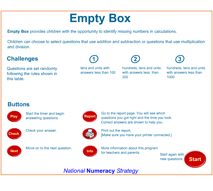Consolidation and practice
These resources are to support children in guided or independent work. Roll over the highlighted resource for a description.
Empty box program

This ICT-based tool can be used by children to practise and consolidate multiplication, division, addition and subtraction, and to develop understanding of inverse operations and when not to use a calculator. Different activities, numbers of questions and operations can be selected to vary the level of challenge.
Opportunities to use and apply
Possible contexts include:
- Word problems, e.g. Erasers weigh 23 g each. They come in a pack of 50. The box weighs 10.5 g. How much will the pack weigh altogether?
- Money problems, e.g. I buy 15 sheets of card that cost 24p each. Use a calculator to work out how much change I will get from £5.
- Shape problems involving area and perimeter, e.g. The perimeter of a rectangular pool is 86 m. The pool is 27.5 m long. How wide is it?
Confirming learning
Use a calculator to solve these problems. Explain your method and record each step:
- Martyn wants to buy some 35p stamps. Work out how many stamps he can buy with £10.
- The letters A, B and C stand for three numbers. A is double B. C is double A. Work out the value of A if A × B × C = 27,000 using trial and improvement.
- At a snack bar, Jay buys three sandwiches that cost £1.75 each. He buys a carton of juice for 85p and a milkshake for £1.20. How much change will he get from a £20 note?
- 320 people attend a school concert. 1/4 of the people are children. The tickets for the concert cost £3.50 for adults and £2 for children. How much ticket money does the school collect?

 = 16.9
= 16.9 Calculating
Calculating

 5 ×
5 ×